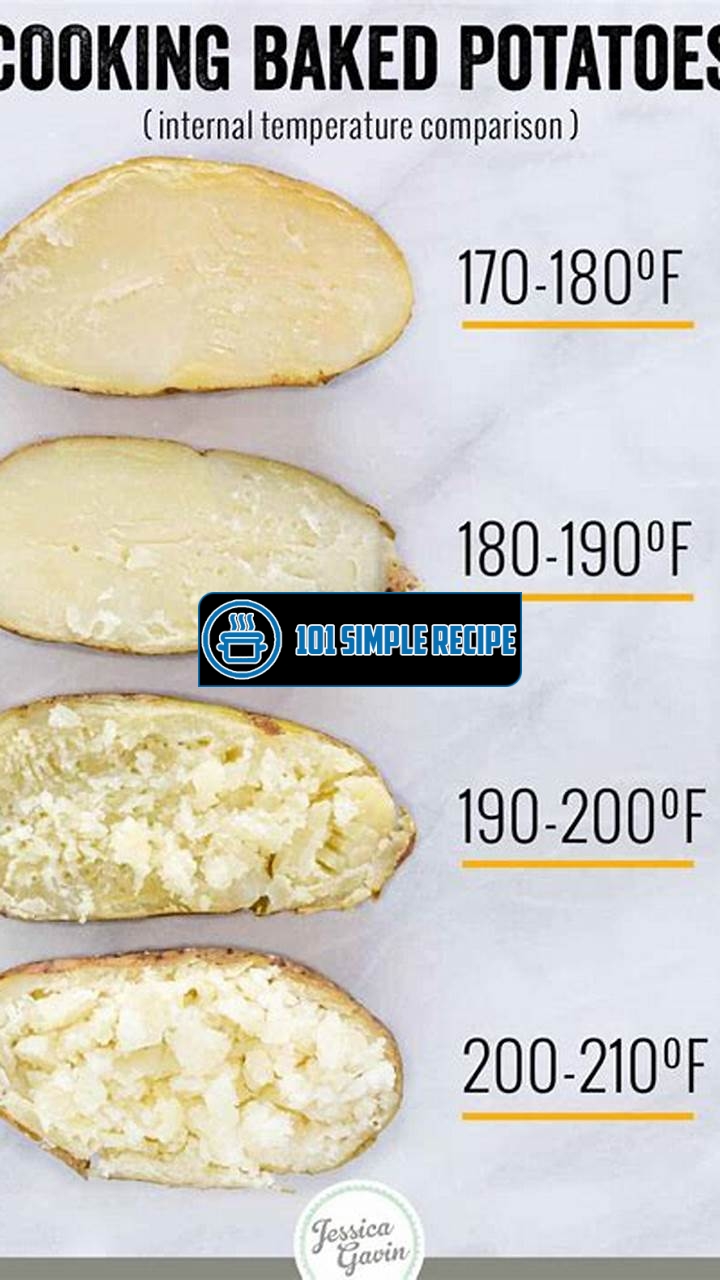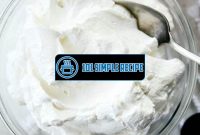Are you tired of biting into a baked potato only to find that it’s either undercooked and hard or overcooked and mushy? Achieving the ideal internal temperature for baked potatoes is the key to ensuring that they are perfectly fluffy and delicious every time. ✨ In this article, we will guide you through the process of achieving the ideal internal temperature for baked potatoes, giving you the secret to achieving potato perfection. Whether you’re a seasoned chef or a novice in the kitchen, this guide will help you master the art of baking potatoes to perfection. So grab your apron and let’s get started!

The Importance of Baked Potato Internal Temperature
Discover why knowing the internal temperature of baked potatoes is crucial for food safety and optimal taste.
What is Baked Potato Internal Temperature?
When it comes to cooking a perfect baked potato, achieving the ideal internal temperature is key. But what exactly is the internal temperature of a baked potato? It refers to the temperature at the center of the potato, which is often measured with a food thermometer. A properly cooked baked potato should have an internal temperature of around 210°F (99°C).
It’s important to note that the internal temperature may vary depending on the desired texture and doneness of the potato. Some people prefer a soft and fluffy texture with a lower internal temperature, while others enjoy a crispy and well-done potato with a slightly higher internal temperature.
Why is Knowing the Internal Temperature Important?
Knowing and monitoring the internal temperature of baked potatoes is crucial for two main reasons: food safety and optimal taste.
Food Safety: Baked potatoes can harbor harmful bacteria, particularly if they are not cooked thoroughly. These bacteria, such as salmonella and E. coli, can cause foodborne illnesses if ingested. By ensuring that the internal temperature reaches a safe level, typically above 165°F (74°C), any potential bacteria present in the potato will be effectively killed off, reducing the risk of food poisoning.
Optimal Taste: Cooking a baked potato to the ideal internal temperature ensures that it is not just safe to eat, but also delicious. When a potato reaches the recommended internal temperature, it becomes tender and evenly cooked. The starches in the potato break down, resulting in a fluffy and creamy texture. Additionally, achieving the right internal temperature allows the flavors to develop fully, resulting in a flavorful and satisfying dish.
How to Measure Baked Potato Internal Temperature
Now that you understand the importance of knowing the internal temperature of baked potatoes, let’s explore how to measure it accurately:
- Start by selecting a reliable food thermometer. Digital thermometers are highly recommended for their accuracy and ease of use.
- Preheat your oven to the desired temperature and prepare your baked potatoes as usual.
- Once the potatoes are cooked and ready to be checked for their internal temperature, carefully insert the food thermometer into the center of the largest potato. Be sure to avoid touching the thermometer to any metal or the baking sheet, as it may provide inaccurate readings.
- Wait for a few seconds until the thermometer stabilizes and displays a reading. The temperature should be around 210°F (99°C) for a perfectly cooked baked potato.
- If the temperature reads below the desired range, put the potatoes back in the oven and continue cooking until the internal temperature reaches the recommended level.
- Once the desired internal temperature is reached, remove the potatoes from the oven and let them cool for a few minutes before serving.
By following these steps and measuring the internal temperature of your baked potatoes, you can ensure that they are safe to eat, perfectly cooked, and bursting with flavor.
If you’re looking to make a complete meal, you can also try our baked potato with toppings recipe.
Food Safety Guidelines for Baked Potatoes
When it comes to cooking baked potatoes, ensuring they reach the ideal internal temperature is crucial in order to guarantee food safety. Understanding the recommended internal temperature will help you avoid any risks associated with undercooked potatoes. In this article, we will take a closer look at the safe internal temperature for baked potatoes, why undercooked potatoes can be unsafe, and common mistakes to avoid when cooking them.
Safe Internal Temperature for Baked Potatoes
According to food safety guidelines, the ideal internal temperature for baked potatoes is 210°F (99°C). Achieving this temperature is necessary as it ensures that any harmful bacteria, such as salmonella, are killed. Consuming undercooked potatoes can lead to food poisoning and result in symptoms such as diarrhea, nausea, and vomiting.
It is important to note that relying solely on visual cues, such as crispy skin or a fork easily piercing through the potato, is not enough to determine if a baked potato is properly cooked. Using a food thermometer is the most accurate way to measure the internal temperature and ensure it reaches the recommended 210°F (99°C).
Why Undercooked Baked Potatoes can be Unsafe
Undercooked baked potatoes can pose a risk to your health due to the presence of harmful bacteria. These bacteria can survive at lower temperatures and may not be killed during the cooking process if the internal temperature is not reached. The ideal internal temperature of 210°F (99°C) ensures that any bacteria present in the potato are effectively eliminated, making it safe for consumption.
Consuming undercooked potatoes can cause food poisoning, which can be particularly dangerous for young children, pregnant women, the elderly, and individuals with weakened immune systems. Therefore, it is crucial to cook baked potatoes thoroughly to avoid any potential health risks.
Common Mistakes to Avoid when Cooking Baked Potatoes
When cooking baked potatoes, it is important to be aware of common mistakes that can lead to undercooking. By avoiding these errors, you can ensure that your potatoes are cooked to the recommended internal temperature, guaranteeing food safety.
1. Insufficient cooking time: One common mistake is not allowing enough time for the potatoes to cook thoroughly. Baked potatoes generally require at least 45 minutes to an hour in the oven to reach the ideal internal temperature. Rushing the cooking process can result in undercooked potatoes.
2. Inadequate preheating of the oven: Failing to preheat the oven properly can also lead to undercooked potatoes. Make sure to preheat your oven to the recommended temperature before placing the potatoes inside. This ensures a consistent and even cooking process.
3. Inconsistent potato sizes: Using potatoes of different sizes can cause inconsistencies in cooking. Smaller potatoes may cook faster, while larger ones may take longer. Choosing potatoes of similar sizes will help ensure an even cooking time.
4. Lack of ventilation: Properly ventilating baked potatoes is essential to avoid excess moisture, which can lead to uneven cooking. Placing the potatoes directly on the oven rack or poking them with a fork allows steam to escape, resulting in a crispier skin and evenly cooked interior.
By keeping these common mistakes in mind and taking the necessary precautions, you can achieve the ideal internal temperature for your baked potatoes and enjoy a safe and delicious meal.
For more delicious recipes, check out our baked potato recipe.
Achieving the Perfect Texture and Flavor
When it comes to baked potatoes, achieving the ideal internal temperature is crucial in order to achieve the perfect texture and flavor. The internal temperature of a baked potato will determine whether it is fluffy and light or crispy and golden-skinned. Additionally, understanding the role of resting time and carryover cooking is essential for achieving the desired result.
Internal Temperature for Fluffy and Light Baked Potatoes
To achieve fluffy and light baked potatoes, it is important to cook them to an internal temperature of around 210°F (99°C). This temperature allows the starches in the potato to fully gelatinize, resulting in a light and fluffy texture. When a potato reaches this internal temperature, it becomes tender and easy to mash or scoop out of the skin.
One of the key factors in achieving this ideal internal temperature is ensuring that the potatoes are evenly cooked. To do this, it is recommended to prick the potatoes with a fork before baking. This allows steam to escape and helps prevent the potatoes from bursting. Wrapping the potatoes in foil can also help retain moisture and promote even cooking.
Once the potatoes reach the desired internal temperature, it is important to remove them from the oven and let them rest for a few minutes before serving. This resting time allows for carryover cooking, where the residual heat continues to cook the potatoes and ensures that they are evenly heated throughout.
Internal Temperature for Crispy and Golden Skinned Baked Potatoes
If you prefer crispy and golden-skinned baked potatoes, a higher internal temperature is required. Aim for an internal temperature of around 220°F to 230°F (104°C to 110°C). This higher temperature helps to crisp up the skin and create a delicious, golden crust.
To achieve this higher internal temperature, it is recommended to bake the potatoes at a slightly higher temperature, around 425°F (220°C). This will help promote browning and crisping of the skin. It is also important to leave the potatoes unwrapped, as this allows the skin to dry out and become crispy.
After baking the potatoes to the desired internal temperature, it is again important to let them rest before serving. This resting time allows the skin to become even crispier and ensures that the interior is fully cooked.
The Role of Resting Time and Carryover Cooking
The role of resting time and carryover cooking should not be overlooked when attempting to achieve the ideal internal temperature for baked potatoes. Resting the potatoes after they are baked allows the heat to distribute evenly throughout the potato, resulting in a consistent texture from the outer skin to the center.
During the resting time, carryover cooking takes place, where the residual heat continues to cook the potato. This is why it is important to remove the potatoes from the oven slightly before they reach the desired internal temperature, as they will continue to cook during this resting period.
Remember, achieving the perfect internal temperature for baked potatoes is key to achieving the desired texture and flavor. Whether you prefer fluffy and light or crispy and golden-skinned potatoes, understanding the temperature ranges and the role of resting time and carryover cooking is essential. So, next time you bake potatoes, keep these tips in mind to achieve potato perfection!
Troubleshooting Baked Potato Issues
When it comes to cooking baked potatoes, there are several common problems that can arise, many of which are directly related to the internal temperature of the potato. Understanding these issues and their connection to internal temperature is crucial in achieving the perfect baked potato every time. Let’s dive deeper into the potential problems and their solutions.
Internal Temperature and Undercooked or Raw Centers
One of the main challenges you might face when cooking baked potatoes is ending up with undercooked or raw centers. This problem usually occurs when the internal temperature of the potato is not properly monitored and regulated. To ensure a fully cooked center, it’s important to follow these steps:
- Preheat your oven to 425°F (220°C) to create a hot cooking environment for the potatoes.
- Thoroughly wash and dry the potatoes, then prick them a few times with a fork to allow steam to escape during cooking. This helps prevent the center from becoming too dense.
- Rub the potatoes with olive oil and sprinkle them with salt to enhance the flavor.
- Place the potatoes directly on the heated oven rack or on a baking sheet lined with parchment paper.
- Bake the potatoes for approximately 45 minutes to 1 hour, or until a thermometer inserted into the center of the potatoes reads at least 210°F (99°C). This ensures that the potatoes are fully cooked and have a fluffy, tender center.
⚠️ Tip: The recommended internal temperature for fully cooked baked potatoes is 210°F (99°C).
Internal Temperature and Dry or Overcooked Baked Potatoes
On the other hand, cooking baked potatoes for too long can result in dry or overcooked potatoes. This problem is often caused by high oven temperatures or extended cooking times. To avoid this issue and achieve perfectly cooked baked potatoes, follow these guidelines:
- Preheat your oven to 400°F (200°C) for a slightly lower and gentler cooking temperature.
- Prepare the potatoes as mentioned earlier, with the same washing, drying, and pricking steps.
- Coat the potatoes with a thin layer of olive oil and season with salt and pepper.
- Cook the potatoes for around 1 hour, or until they reach an internal temperature of 200°F (93°C). This lower internal temperature ensures a moist and creamy texture.
⚠️ Tip: To check the internal temperature, insert a meat thermometer into the thickest part of the potato without touching the skin.
Solutions for Unevenly Cooked Baked Potatoes
Unevenly cooked baked potatoes can be disappointing, especially when some parts are overcooked while others remain undercooked. The key to solving this problem lies in creating an even cooking environment. Here’s how:
- Start by selecting potatoes of similar size to ensure they cook at the same rate.
- Follow the preparation steps mentioned earlier, including washing, drying, pricking, and seasoning the potatoes.
- Wrap each potato individually in aluminum foil to help distribute the heat evenly.
- Place the foil-wrapped potatoes on a baking sheet and bake them for approximately 1 hour, or until they reach an internal temperature of 210°F (99°C).
⚠️ Note: While wrapping the potatoes in foil helps with even cooking, it can result in a softer skin. If you prefer a crispy skin, omit the foil wrapping and bake the potatoes directly on the oven rack or a baking sheet.
By following these troubleshooting tips and paying attention to the internal temperature of your baked potatoes, you can achieve the ideal texture and flavor every time. Enjoy your deliciously cooked potatoes!
Additional Tips and Variations
When it comes to achieving the ideal internal temperature for baked potatoes, there are a few additional tips and variations that can take your cooking skills to the next level. Here, we explore some techniques and ideas that will surely elevate your baked potato game.
Seasoning and Flavoring at Different Internal Temperatures
One interesting variation to consider is seasoning and flavoring your baked potatoes at different internal temperatures. This can result in a unique and delicious taste experience. For example, you can start by seasoning the outside of the potato with olive oil, salt, and pepper before baking it at a lower temperature. This allows the flavors to penetrate the skin and infuse into the flesh, resulting in a flavorful and well-seasoned potato with a crispy exterior. On the other hand, if you prefer a stronger flavor, you can wait until the potato reaches a higher internal temperature before adding seasoning or toppings. This will help to intensify the flavors and create a bolder taste profile.
Stuffing and Topping Baked Potatoes with Different Internal Temperatures
Another exciting way to experiment with the internal temperature of baked potatoes is by stuffing and topping them in various ways. The internal temperature can affect how the toppings and fillings interact with the potato’s texture and taste. For instance, if you want a gooey and melted cheese topping, it’s best to add it when the internal temperature is at its peak. This will ensure that the cheese gets fully melted and creates a satisfyingly cheesy experience. On the other hand, if you prefer a crunchier topping, such as crispy bacon or breadcrumbs, it’s best to add them towards the end of the baking process, when the potato is reaching its ideal internal temperature. This way, the toppings will stay crisp and add a delightful contrast to the soft potato flesh.
Exploring Different Types of Potatoes for Baking
Lastly, don’t be afraid to explore the world of potatoes when it comes to baking. There are various types of potatoes available, each with its own unique flavor and texture. Trying out different potato varieties can add a whole new dimension to your baked potato dishes. For example, Russet potatoes are known for their fluffy and starchy texture, making them perfect for baking. They can result in a light and airy interior with a crisp skin. On the other hand, Yukon Gold potatoes have a creamier texture and slightly sweet flavor, which can add an interesting twist to your baked potato creations. Feel free to experiment with different potato types and discover your favorite!
With these additional tips and variations, you can truly elevate your baked potato cooking skills and create dishes that are packed with flavor and excitement. Don’t be afraid to get creative and enjoy the process of experimenting with different techniques, seasonings, stuffings, and potato varieties. Remember to pay attention to the internal temperature of your baked potatoes and adjust your cooking methods accordingly for a truly perfect result. Happy baking!
Want to learn about the ideal internal temperature for a baked potato? Check out our article on baked potato internal temperature.
Thank you for taking the time to read our article on baked potato internal temperature. We hope you found the information helpful in achieving the perfect baked potato every time. If you have any further questions or would like more tips and tricks, please feel free to visit again later. Happy baking!
Frequently Asked Questions
Here are some commonly asked questions about baked potato internal temperature:
| No. | Questions | Answers |
|---|---|---|
| 1. | What is the ideal internal temperature for a baked potato? | The ideal internal temperature for a baked potato is 210°F (98°C). This ensures that the potato is fully cooked and soft on the inside. |
| 2. | How do I measure the internal temperature of a baked potato? | To measure the internal temperature of a baked potato, simply insert a meat thermometer into the thickest part of the potato. Be careful not to touch the thermometer to the skin, as it may give an inaccurate reading. |
| 3. | Can I eat a baked potato if it has not reached the ideal internal temperature? | It is not recommended to eat a baked potato that has not reached the ideal internal temperature. The potato may not be fully cooked and could cause foodborne illness. |
| 4. | What should I do if my baked potato has not reached the ideal internal temperature? | If your baked potato has not reached the ideal internal temperature, you can continue cooking it for a few more minutes until it reaches the desired temperature. |
| 5. | What factors can affect the cooking time and internal temperature of a baked potato? | The cooking time and internal temperature of a baked potato can be affected by factors such as the size of the potato, the oven temperature, and the altitude at which you are cooking. |
| 6. | Can I microwave a potato to achieve the ideal internal temperature? | Yes, you can microwave a potato to achieve the ideal internal temperature. However, microwaving may result in a different texture compared to baking in the oven. |
Closing Thoughts
We hope this article has provided you with valuable information on achieving the perfect baked potato internal temperature. Remember to always use a meat thermometer to ensure your potatoes are thoroughly cooked. For more cooking tips and recipes, be sure to visit our website again soon. Happy cooking!
Jump to Recipe
Baked Potato Internal Temp

Learn about the ideal internal temperature for a perfectly baked potato.
- 4 large russet potatoes
- Olive oil
- Salt and pepper to taste
- Preheat the oven to 400°F (204°C).
- Wash and dry the potatoes. Prick the potatoes several times with a fork.
- Rub the potatoes with olive oil and season with salt and pepper to taste.
- Place the potatoes directly on the oven rack and bake for approximately 60 minutes.
- Insert a meat thermometer into the thickest part of the potato. The internal temperature should reach 210°F (98°C).
- Once the potatoes have reached the ideal internal temperature, remove them from the oven and let them cool for a few minutes. Serve with your favorite toppings and enjoy!






